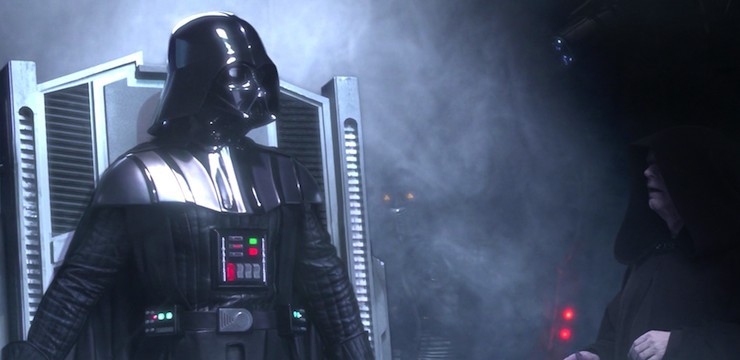Two prequels down, one to go. And it was strange, because being a longtime Star Wars fan created different expectations for Episode III—you see, we all knew how it was supposed to end.
Lemme get into that.
In the novelization of Return of the Jedi, ghost Obi-Wan gives Luke a little more information on dear old dad, hoping to convince the kid that there is no part of Anakin Skywalker left under the big black cape. I’ll give you a proper quote block once we get to the reread for Episode VI, but what he said basically boiled down to “We fought over a pit of lava and your father fell in. And when he emerged from that pit, he was no longer the man I knew—he was Darth Vader.” So the real question boiled down to… was Lucas going to stick to the original plan? Would fans get to see that legendary fall out on a big screen?
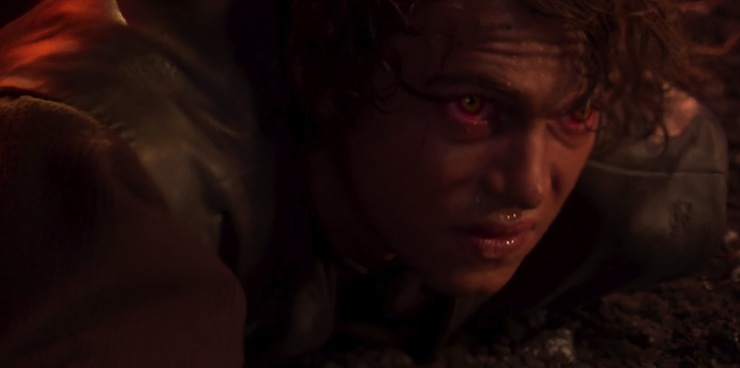
The answer, surprisingly, was yes. And I say surprisingly because Lucas changed his mind often in the making of these films, as was his prerogative. The fact that he was determined to have this particular moment stand speaks to how essential he felt it was to the Star Wars myth.
Because in the end, this was the prequel chapter that Lucas was always the most certain of, with the previous two films serving as lead-up to the main event. The track released prior to the film was “Battle of the Heroes,” and while it had similarities to “Duel of the Fates” with the choir and ominous tones, it was a laboring, tragic piece of music. Promotional stills and eventually the trailer showed exactly what Lucas had alluded to decades prior—a fight over a landscape of lava, our two heroes locked in combat while the world fell apart around them.
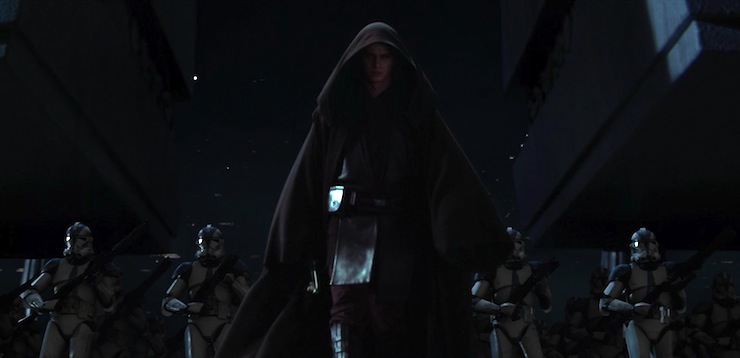
There was one other event that fans were curious about seeing on film: the Jedi Purge. Alluded to in all forms of Star Wars media, this genocide against the Jedi Order was always a part of the Star Wars narrative… but it was never a guarantee that the film would show it. After all, Star Wars films are generally rated PG, and mass slaughter doesn’t really partner with that rating. Once the PG-13 rating was locked in, it suddenly became far more likely. Fans had mixed feelings about this, many concerned that their younger children wouldn’t be able to handle the violence, but it’s hard to dispute Lucas’ call in this particular instance. A tale about the ultimate fall from grace, if Anakin Skywalker doesn’t truly commit any atrocities that the audience can see, his redemption becomes hollow.
But is Revenge of the Sith a good movie? Even in its best moments it never truly reaches the height of the original trilogy, though it’s not for lack of trying. There are just a few too many critical errors that rob Episode III of greatness. I’ll try to parse them out below….
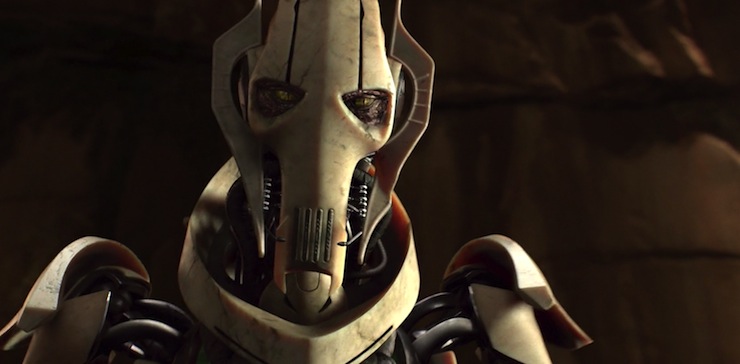
Let’s start off with the second biggest problem in the whole film: General Grievous. Here’s a character we’ve had zero introduction to, who we’re told right off is extremely important. Which is #1 on the How Not to Make A Character list. Fine, he’s a cool-looking robot-being (even if his CGI doesn’t always look as pristine as it needs to), and I understand the impulse to create a sort of proto-Vader (this was Lucas’ stated intention with Grievous) even if there’s no real reason why that enhances Vader’s narrative. The problem is simple—he’s filling the role that Count Dooku should be filling in the film. Whether this was due to Christopher Lee’s desire for limited screen time, or simply a logistical issue, it’s painfully obvious. The sloppy introductions in Episode II mean that we don’t know Dooku well, and we should know him better. Having Obi-Wan go after him to potentially end the Clone War makes narrative sense, both in terms of Dooku’s position as leader of the Seperatists, and in terms of Obi-Wan’s personal character arc. He already has a bone to pick with the guy and there’s the added relevance of Qui-Gon being Dooku’s Padawan. It’s a personal journey that it makes sense for Obi-Wan to take.
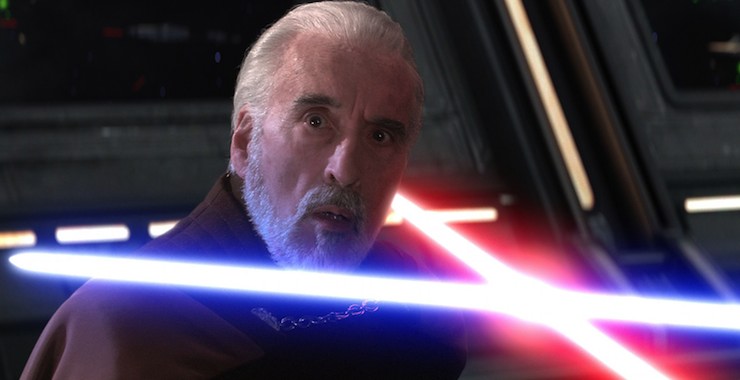
Barring that, we end up with a trilogy in which a new villain takes center stage every single movie. It’s so unnecessary, and prevents us from being able to form attachments to any of them. So Dooku dies, and now there’s this guy, who comes off as both lumbering and cowardly, and never does anything remotely intelligent to indicate why he’s in charge of stuff in the first place. (Yet again I’m forced to plug the Clone Wars cartoon, where we get more of both Dooku and Grievous, and finally understand why our heroes are so very keen to bring them down on a personal level.) Obi-Wan kills Grievous quickly once he locates the guy, robbing him of any impact he might have had. With that, his true purpose in the story becomes entirely transparent; he’s an obstacle set in place so that Obi-Wan is out of the way for Anakin’s turn to the dark side. It’s fine for that to be part of Sidious’ machinations, but doing it with a character that has no teeth is a bad decision for the story because it makes Obi-Wan’s part in this tale pointless and boring to boot.
The most important problem is the sidelining and alteration of Padmé’s entire character into a sad, scared pregnant woman who never possesses even a modicum of the power she displayed in the first two films. And this was a bad choice of editing; Lucas had written and shot scenes that showed Padmé, Bail Organa, and a young Mon Mothma working together to germinate what would eventually become the Rebel Alliance, but none of those scenes make it into the film. So Padmé spends the majority of the movie at home, worried about Anakin, brushing vaguely at her perfect curled locks, and sleeping in nightgowns that have pearls at the shoulders because who doesn’t want to wake up in the morning with perfect imprints of wealth and status coded into their arms?
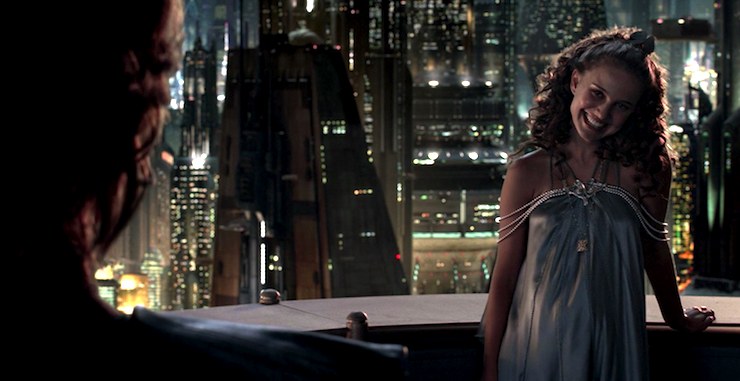
It’s really too bad because this was the place where the romance had to work. And while Portman and Christensen were clearly given leave to loosen up a little, the dialogue does nothing to help their situation. The film also manages not to address one of the most interesting aspects of the Padmé’s pregnancy; the fact that she’s clearly about eight months along by the time Anakin sets foot back on Coruscant. Senator Amidala has been dealing with the majority of her pregnancy alone and unaided, terrified to tell anyone for fear of the scandal it will cause. (Though I wish we had more clarity on why she believes Naboo’s queen will no longer allow her to serve on the Senate once the pregnancy comes to light—is it because she fears that the queen will find out about who the father is, or because she might raise them alone without acknowledging the father publicly, or simply because she’s a woman who decided to have kids alongside her high-pressure job? Because none of those answers seem reasonable; even if the fear is that their relationship will be exposed, the Jedi Order is the one with rules about attachments. It’s not like the Senate has a “don’t date Jedi” rule. If the worry is that public opinion on Amidala will shift as a result of her affair, that needs to be made clear.) What we get instead is Padmé sighing over the heady first days of their romance, when her dear husband professed to her his extreme distaste for sand, and scolded her for forgetting that he was in charge of security here m’lady. Not exactly a riveting arc for the prequel trilogy’s only main female character.
It doesn’t help that she’s busy gasping over Anakin’s alleged murder of Jedi younglings when he admitted to the exact same hobby in the previous film.
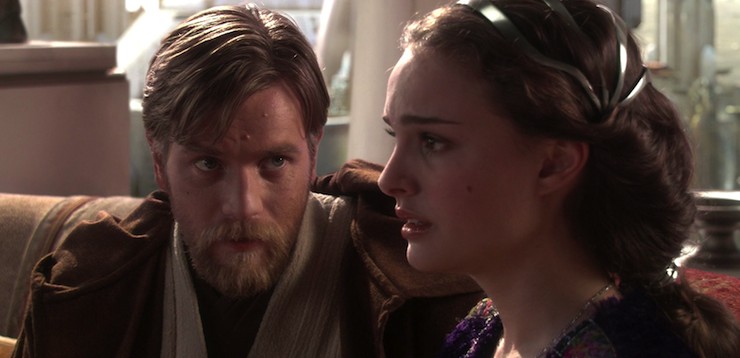
While Padmé is left by the wayside, Ian McDiarmid is finally given his time to shine as Palpatine, and he skins those scenes with his teeth. He is genuinely frightening and engaging, but his seduction of Anakin is something that really needed to be present in the previous films. We needed more indication of Palpatine’s guiding hand throughout Anakin’s life, something that we are told is true rather than shown. His offer to teach Anakin how to keep his loved ones alive via the Force could have easily been slipped into the previous film when Anakin was having nightmares about his mother. Doing that would have made Anakin’s fall feel more gradual; he’s had time to ruminate on all the ideas and offers that Palpatine has been filling his head with for years, and finally comes to a breaking point when Padmé’s life is in danger. Instead, it seems that Anakin just panics and immediately swaps teams due to one sad dream where Padmé cries and asks for help. He’s meant to be a hero of the Republic, a genuine one despite his many flaws—it shouldn’t look so easy to quash years of resolve and Jedi training.
(And again. Clone Wars cartoon. We suddenly get a sea of background that illustrates Anakin’s issues with fear, death, jealousy, and anger, and watch those problems evolve and effect him over time, making his fall something that we can track and appreciate. And he’s likable on top of it, so you feel bad for the guy!)
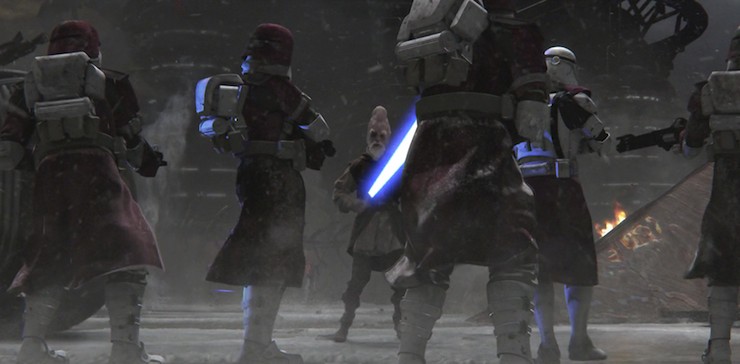
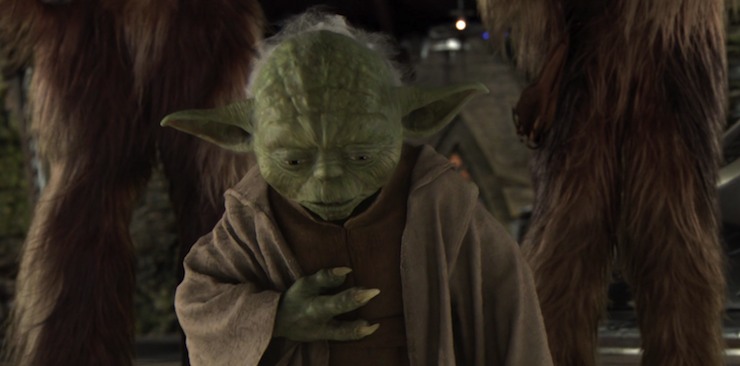
And it’s too bad because the Jedi Purge is appropriately wrenching cinematically. I remember crying in the theater—many of the random Jedi we see gunned down were given background via the Expanded Universe, so these characters did matter to me. The unstoppable wave of death that encompasses the final act is terribly effective. The moment where that wave finally hits Yoda, and he stumbles in grief, is horrible to watch. It’s worse by the time Obi-Wan knows the truth because Ewan McGregor is finally playing the character with the sort of dimension that he was forced to skip in the previous movie. His banter and more emotional moments with Anakin in the first half of the film are unfortunately doing the work that two more films needed to be doing already, cramming fourteen years of love and friendship into a few scenes of footage. Which is too bad, because the rescue they bring off at the start of the film shows us glimpses of what the prequels could have been all the way through. (See: Clone Wars cartoon. I’m just gonna keep tacking it on until it becomes a subliminal message.)
By the time we get to the final duel, the audience is revved and ready for it… and then has to suffer through the intercut Sidious-Yoda fight. Which is a fight that, for the record, should have never contained lightsabers. It’s hard enough to believe that Palpatine is an agile duelist in the first place, but how much more relevant would that face-off have felt if it were about Yoda and Palpatine showcasing their raw connection to the Force? More lightning, more push and pull, less crashing Senate platforms and jumping about. Because this fight is not truly a parallel to Obi-Wan and Anakin’s; it’s about something completely different. Yoda is fighting for the right of the Jedi to survive, while Anakin’s battle with Obi-Wan is utterly personal in every way. It’s the death of their partnership, their friendship, their fealty to each other. The duel itself is beautifully choreographed, and works well in conversation with the previous duels of the prequels. As though everything has been leading up to this, a one-on-one blitz of motion and pain, where the lightsabers themselves seem to barely matter at all. It’s just too bad that the fight is overlong by about two sections, and is burdened by dry dialogue that does nothing to communicate the emotional turmoil we are seeing on screen.
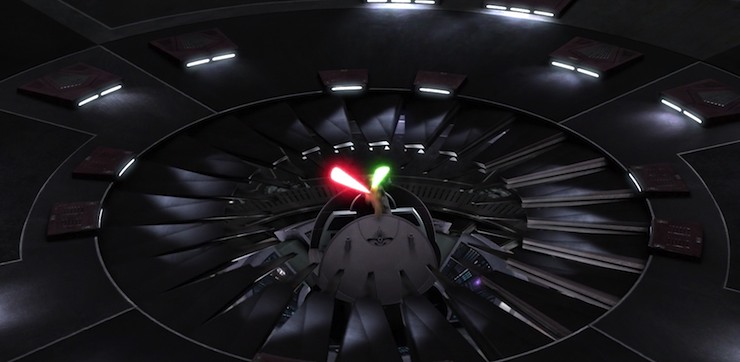
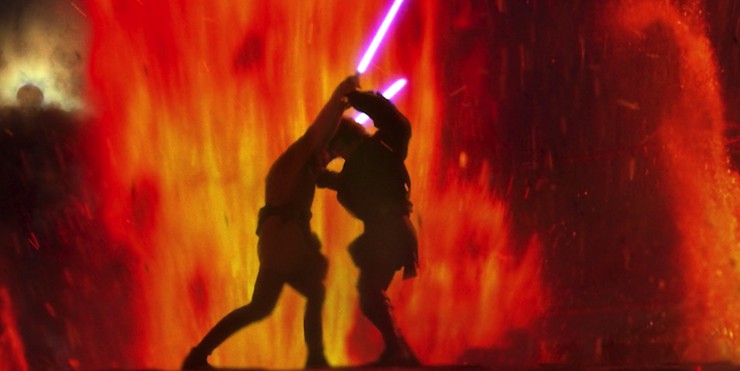
It’s not as though George Lucas didn’t know what story he meant to tell; according to Hayden Christensen, one of the most important directions he got from Lucas during Revenge of the Sith was “You haven’t truly fallen to the dark side until you’re able to look up at your best friend and tell him that you hate him.” That’s some shrewd characterization, and an acknowledgement that Anakin is conflicted about his path through practically the entire film. But instead of showing us that breakdown, we’re treated to a strange moralizing speech from Obi-Wan about how Anakin was supposed to do Prophecy stuff. Leave it off, dude. Just tell him that you loved him… and leave. It’s a far more effecting move.
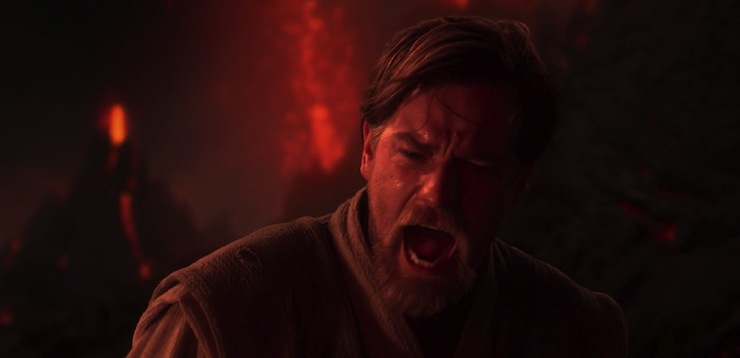
And then the movie ends on a weird downturn, where we’re supposed to buy that Padmé just gives up on life after having her babies because sadness, and then we are subjected to the joy of James Earl Jones’ voice only to have the moment ripped away when he’s forced to shout “NOOOOOOOOOOOO” into a strange void forever. And it’s horrible because what Palpatine is doing in that moment is important, it informs Vader’s entire arc going forward, and we just tune out because it’s too awkward to watch. (Fans have also had to do quite a bit of mental gymnastics to get around the “give up on life” bit, and this is by far the best theory to that effect.) It’s great to see the twins off to their respective homes—we get to see Alderaan for the first time!—but it’s hard to shake off all those unsatisfying threads.
There are many excellent moments in Revenge of the Sith, but at the end of an entire trilogy, it simply had too much ground to make up for. If anything, it’s a lesson in planning, proving that you can’t end-load a tale with so much emotional weight tacked onto it. And yet, for all that, it’s so important that it exists at all. That we were given a glimpse of this faraway galaxy’s history, it’s opening saga.
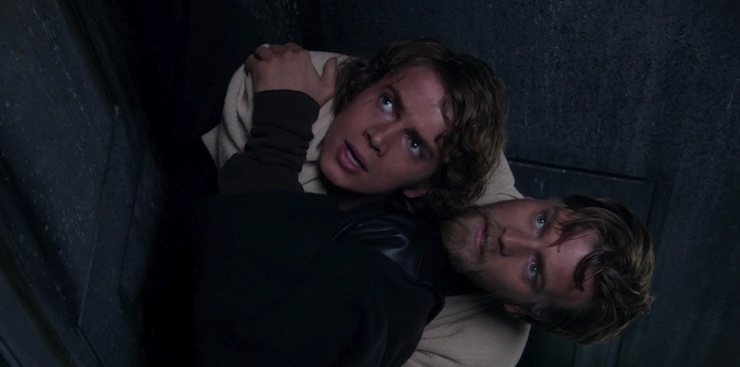
Don’t worry, my friends. The Episode III novelization will soothe every hurt and make things right. Bold assertion? Yes. Which makes me very excited to get its reread this week. Stay tuned.
Emmet Asher-Perrin would have gladly watched a whole film of Anakin and Obi-Wan banter before this one. You can bug her on Twitter and Tumblr, and read more of her work here and elsewhere.










